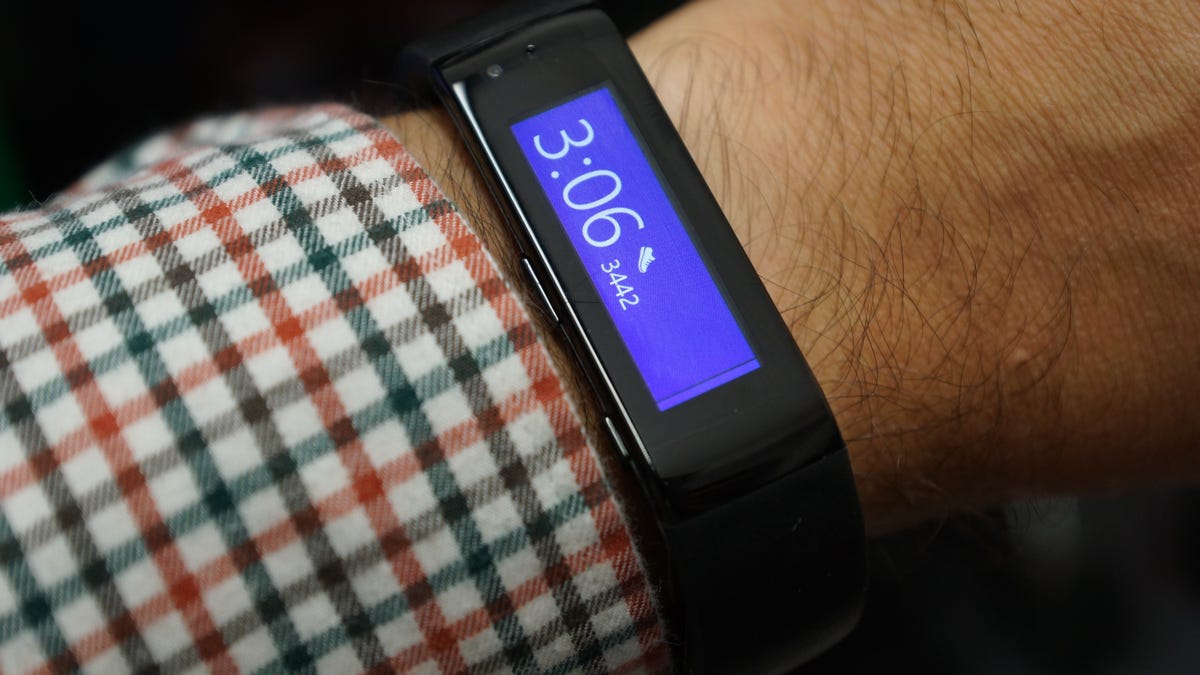
The Microsoft Band is the company's first modern wearable product. It's available now for $199 in the US. Availability for the UK or Australia has not yet been announced, but the price would directly convert to about £125 or AU$225.
Unlike Android Wear devices and the Apple Watch, the Microsoft Band is more OS-agnostic: it works with Android, iOS and Windows Phone devices alike.
The Microsoft Health app has a clean design and feels like a part of Windows Phone that escaped and lives on my iPhone. The Band's background colors can be changed, and app and feature tiles can be swapped out and workouts added. Charts and graphs show trends and activity over time, much like other data-rich fitness apps. The app connects with RunKeeper and MyFitnessPal to start, allowing synchronized food and social run-tracking.
Microsoft's simplified tile-based interface shows time, fitness data and app-like tiles for smart features. A second button also starts workouts.
The Microsoft Band tracks steps, and also 24-hour heart rate. Once it locks in, it's easy to instantly see your heart activity. At night, the Band tracks sleep based on accelerometer and heart rate info, and calculates your resting heart rate overnight. During the day, active heart activity during workouts gets analyzed based on heart rate data already collected.
The sides are practically bulging with what feels like batteries, and the back buckle contains the optical heart-tracking green LEDs (shown here).
For workouts, the Microsoft Band can work with any gym activity, from weightlifting to ellipticals. There are also downloadable workout sessions from partners like Gold's Gym and Men's Fitness that are free to install on the band. Put them on the Band and they'll guide you to training sessions and track when you've completed each activity.
The flat OLED touch display only turns on when you press the side button, and doesn't turn on automatically, but it's bright and vivid.
There's even a Starbucks mini-app that can load your bar code for payments at a local store: I tried and it worked like a charm for my daily iced coffee.
The Band comes in three sizes, and each one is slightly adjustable. I got the large one, and I put it on the tightest setting. The band clips on using a spring mechanism that feels secure.
There's also built-in GPS for runners, making this a standalone running accessory. Go jogging without a phone and it'll track your data and location, and map your run and how intensely you ran when you sync with your phone. Microsoft claims 5 hours of GPS battery life, or 48 hours for other activities.
The band also has a UV sensor so when you step outdoors it can tell you how much sun you're getting. No other fitness band I can think of has a UV sensor.
The Microsoft Band seems nearly perfect at first glance. Its biggest limits are that it's not swim- or shower-friendly, its battery life is significantly shorter than competing fitness-based bands and watches manage, and it feels a little awkward on the wrist. Stay tuned for a full review, but so far Microsoft looks like it's made some pretty smart moves...ones that makers of devices like Samsung Gear Fit should have tried a long time ago.

